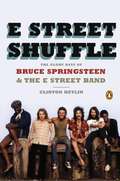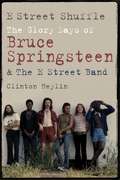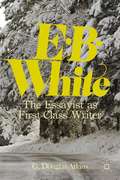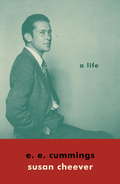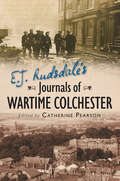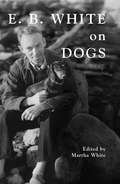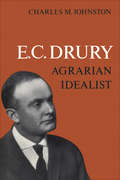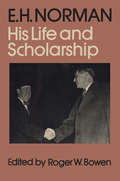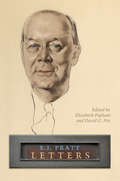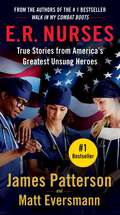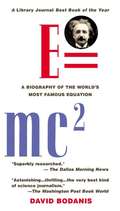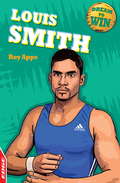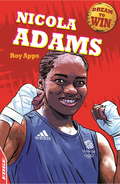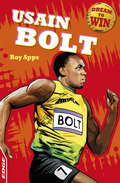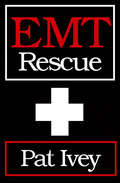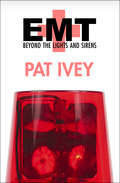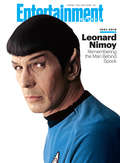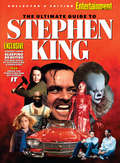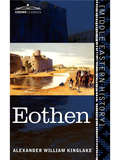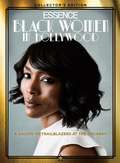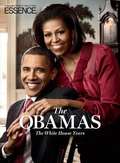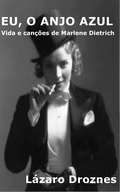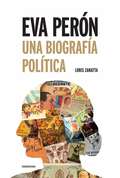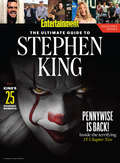- Table View
- List View
E Street Shuffle: The Glory Days of Bruce Springsteen & the E Street Band
by Clinton HeylinFrom Clinton Heylin, an intimate look at one of rock's brightest stars and his legendary backing band.
E Street Shuffle: The Glory Days of Bruce Springsteen and the E Street Band
by Clinton HeylinBruce Springsteen is one of the most important and controversial rock stars of our times: this is the story of the man - a complex, poetic loner whose albums went on to sell 18 million copies - and the band that gave his inner vision a punch and a swagger. Clinton Heylin has written the most factually accurate, informative book on Springsteen to date. As in Heylin's definitive Bob Dylan title Revolution in the Air, E Street Shuffle will focus on Bruce Springsteen and his work: the songs he's written, the way they were recorded, how they sounded live. Heylin also has unparalleled access to the people around Springsteen: current and former members of the E Street Band; CBS A&R personnel; Springsteen's 'New Dylan' contemporaries, as well as fellow Asbury Park musicians and scenesters, and rock critics. This is the essential book for any fan of the Boss.Praise for Clinton Heylin:"Arguably the world's greatest rock biographer." - The Irish Independent."The only Dylanologist worth reading." - The New York Times.
E. B. White: The Essayist as First-Class Writer
by G. Douglas AtkinsThis is the first book-length critical study of E. B. White, the American essayist and author of Stuart Little, Charlotte's Web, The Trumpet of the Swan . G. Douglas Atkins focuses on White and the writing life, offering detailed readings of the major essays and revealing White's distinctiveness as an essayist.
E. E. Cummings
by Susan CheeverFrom the author of American Bloomsbury ("Beguiling" --Publishers Weekly), Louisa May Alcott ("Fascinating . . . Another splendid piece of work with hidden depths by Susan Cheever"--Michael Korda), and Home Before Dark ("Moving and brilliantly restrained"--The New York Times Book Review), a major reassessment of the life and work of the novelist, painter, and playwright considered to be one of America's preeminent twentieth-century poets, our generation's beloved heretic. At the time of his death in 1962, at age sixty-eight, he was, after Robert Frost, the most widely read poet in the United States. E. E. Cummings was and remains controversial. He has been called "a master" (Malcolm Cowley); "hideous" (Edmund Wilson). James Dickey called him a "daringly original poet with more vitality and more sheer uncompromising talent than any other living American writer." In Susan Cheever's rich, illuminating biography we see Cummings's idyllic childhood years in a mythic part of Cambridge, Massachusetts (the Cummings house was within calling distance of Harvard professor William James, who first introduced Cummings's parents); his Calvinist father--distinguished Harvard professor and sternly religious minister of the Cambridge Congregational Church; his mother--loving, attentive, a source of encouragement, the aristocrat of the family, from Unitarian writers, judges, and adventurers. We see Cummings--slight, agile, playful, a product of a nineteenth-century New England childhood, bred to be flinty and determined; his love of nature ("here my enormous smallness entered Her illimitable being"); his sense of fun, laughter, mimicry; his desire from the get-go to stand conventional wisdom on its head, which he himself would often do, literally, to amuse. At Harvard, he roomed with John Dos Passos; befriended Lincoln Kirstein; read Latin, Greek, and French; earned two degrees; discovered alcohol, fast cars, and burlesque at the Old Howard Theater; and raged against the school's conservative, exclusionary upper-class rule by A. Lawrence Lowell. In Cheever's book we see that beneath Cummings's blissful, golden childhood the strains of sadness and rage were already at play. He grew into a dark young man and set out on a lifelong course of rebellion against conventional authority and the critical establishment, devouring the poetry of Ezra Pound, whose radical verses pushed Cummings away from the politeness of the traditional nature poem toward a more adventurous, sexually conscious form. We see that Cummings's self-imposed exile from Cambridge--a town he'd come to hate for its intellectualism, Puritan uptightness ("the Cambridge ladies," he wrote, "who live in furnished souls"), racism, and self-righteous xenophobia--seemed necessary for him as a man and a poet. Headstrong and cavalier, he volunteered as an ambulance driver in World War I, working alongside Hemingway, Joyce, and Ford Madox Ford . . . his ongoing stand against the imprisonment of his soul taking a literal turn when he was held in a makeshift prison for "undesirables and spies," an experience that became the basis for his novel, The Enormous Room, of which F. Scott Fitzgerald wrote: "Of all the work by young men since 1920--one book survives." We follow Cummings as he permanently flees to Greenwich Village to be among other modernist poets of the day--Marianne Moore, Hart Crane, Dylan Thomas--and we see the development of both the poet and his work against the backdrop of modernism and through the influences of his contemporaries: Stein, Amy Lowell, Joyce, and Pound.Cheever's fascinating book gives us the evolution of an artist whose writing was at the forefront of what was new and daring and bold in an America in transition.(With 28 pages of black-and-white images.)From the Hardcover edition.
E. J. Rudsdale's Journals of Wartime Colchester
by Catherine PearsonE.J. Rudsdale’s role as a museum curator and air-raid shelter superintendent at Colchester Castle during the Second World War gave him the perfect opportunity to record life on the Home Front in his journals. Seventy years later, the selected extracts gathered here provide a remarkable insight into wartime life. Rudsdale’s writing is characterised throughout by his wry observations of wartime officialdom and his lack of conformity with the prevailing views of the time. He was a pacifist, which gives his journals an unusual perspective. However, even as a civilian he could not escape the conflict, living in a garrison town threatened by invasion and regular bombing raids. His journals, therefore, record anxious and tragic events, but throughout it all his sense of humour is never diminished. This absorbing collection demonstrates Rudsdale’s ability to bring a scene vividly to life and each account highlights the daily pressures that people endured as they valiantly tried to carry on with normal life in spite of the war.
E.B. White on Dogs
by Martha WhiteIn E. B. White on Dogs, his granddaughter and manager of his literary estate, Martha White, has compiled the best and funniest of his essays, poems, letters, and sketches depicting over a dozen of White's various canine companions. Featured here are favorite essays such as 'Two Letters, Both Open,' where White takes on the Internal Revenue Service, and also 'Bedfellows,' with its 'fraudulent reports'; from White's ignoble old dachshund, Fred. ('I just saw an eagle go by. It was carrying a baby. ') From The New Yorker's 'The Talk of the Town' are some little-known Notes and Comment pieces covering dog shows, sled dog races, and the trials and tribulations of city canines, chief among them a Scotty called Daisy who was kicked out of Schrafft's, arrested, and later run down by a Yellow Cab, prompting The New Yorker to run her 'Obituary. ' Some previously unpublished photographs from the E. B. White Estate show the family dogs, from the first collie, to various labs, Scotties, dachshunds, half-breeds, and mutts, all well-loved. This is a book for readers and writers who recognize a good sentence and a masterful turn of a phrase; for E. B. White fans looking for more from their favorite author; and for dog lovers who may not have discovered the wit, style, and compassion of this most distinguished of American essayists.
E.C. Drury: Agrarian Idealist
by Charles M. JohnstonIn a fiercely fought provincial election in 1919, a new political movement came to power in Ontario. The victorious party was the United Farmers of Ontario. Its leader, Ernest Charles Drury (1878-1968), became the province's eighth premier. Idealistic agrarian reformer, staunch temperance man, free-trade advocate, Simcoe County 'yeoman,' and progressive populist, Drury was a man of the people and of the land, inevitably tagged the Farmer Premier. In this biography, Charles M. Johnston follows the career of Drury through agrarian activism and partisan politics, and explores the personal and ideological forces that directed him. Drury began his career in the farm movement as leader of the Dominion Grange and Farmers' Alliance. He went on to act as the driving force behind the Canadian Council of Agriculture, and then co-founded the UFO in 1913. Activist though he was, Drury as a premier sought no dramatic departures from established political procedures. When others of his party did, notably J.J. Morrison and W.C. Good, Drury disavowed their class-consciousness and their formula of group government. Instead he advocated the creation of a people's party, based on what he called Broadening Out – an appeal to all citizens, regardless of class, occupation, or political stripe, who were seen to share the farmer's desire for a more humane, moral, and progressive society in the wake of the First World War. The question of Broadening Out was a controversial one within agrarian ranks, and it led to dissension among the leaders. This weakening of the party combined with the shrewd tactics of Howard Ferguson's Tories to bring about the Drury government's downfall in 1923. During its four years in power it had enacted some solid social welfare legislation, but its defeat was resounding. With it came the effective end of Drury's political career. Johnston offers a revealing study of a brief chapter in Ontario history and of the man whose principles and ideals shaped it.
E.H. Norman: His Life and Scholarship
by Roger W. BowenThe ashes of Herbert Norman now lie in the British cemetery at Rome, near those of Shelley and Keats. His distinguished life and tragic death, in April 1957, are recalled and examined in this book by scholars and diplomats from four countries--the United States, Japan, Canada, and Britain.Born in rural Japan the son of a Canadian missionary, Herbert Norman studied at the University of Toronto and went in 1933 to Cambridge University on a scholarship. There, in that intellectual hothouse where it seemed one had to choose politically between communism and fascism as the future of the West, he joined the Communist party--a move that became a crime later in the fixed and 'sightless' (as the editor describes them) eyes of his American accusers.According to Edwin Reischauer, later the US ambassador to Japan, 'his harassment by the American government was unforgiveable.' His suicide in Cairo, while Canadian ambassador to Nasser's Egypt during and after the delicate times of the Suez Crisis and the establishment of the UN peace-keeping force, raised broader questions for Lester Pearson--'the right, to say nothing of the propriety, of a foreign government to intervene' in Canadian affairs.Norman was also a renowned historian of Japan. His Japan's Emergence as a Modern State has been called a classic, and between 1946 and 1950, as head of the Canadian Liaison Mission in Tokyo, he was a close and friendly adviser to General Douglas MacArthur in his efforts to reconstitute that country. Both this work and his writings on Japan were sympathetic to human freedoms and democracy, and they too became controversial as sides congealed in the Cold War. Five papers in this book assess Norman's scholarly work in the historiography of Japan.Four lecture papers by Norman (three previously unpublished) are included which show his change from 'a doctrinaire Marxist to a Jeffersonian Liberal,' a change historians can accept as fact whereas intelligence agencies could not and remade Norman into a communist. He was not a spy, the editor concludes, and should be remembered as the hero of a modern tragedy.
E.J. Pratt: Letters
by Elizabeth A. Popham David G. Pitt E.J. Pratt LibraryThis edition of E.J. Pratt’s letters is the final volume in the Collected Works series. Because of Pratt’s role in the making of Canadian culture between and after the World Wars, his correspondence highlights key moments in our cultural history and provides a view of the enterprise from its very centre. The letters take us into his "workshop," illuminating the research behind his distinctive documentary long poems and the social nature of his creative production. They also reveal the complex network of writers, critics, artists and political figures of which Pratt was a part, the evolution of the Canadian book trade from the 1920s through to the early 1960s, and the emergence of radio (and specifically, of the Canadian Broadcasting Corporation) as a tool for forging national identity. Pratt's correspondence both confirms the public persona of one of Canada’s first literary celebrities and provides glimpses of the private character behind the mask.
E.R. Nurses: True Stories from America's Greatest Unsung Heroes
by James Patterson Matt EversmannJames Patterson and Matt Eversmann, #1 bestselling coauthors of Walk in My Combat Boots, powerfully present the medical frontline heroes who work to save our lives every day: E.R. Nurses. <p><p> Around the clock, across the country, these highly skilled and compassionate men and women sacrifice and struggle for us and our families. You have never heard their true stories. Not like this. From big-city and small-town hospitals. From behind the scenes. From the heart. This book will make you laugh, make you cry, make you understand. When we’re at our worst, E.R. nurses are at their best.
E=mc2: A Biography of the World's Most Famous Equation
by David BodanisAlready climbing the bestseller lists-and garnering rave reviews-this "little masterpiece" sheds brilliant light on the equation that changed the world. Bodanis begins by devoting chapters to each of the equation's letters and symbols, introducing the science and scientists forming the backdrop to Einstein's discovery-from Ole Roemer's revelation that the speed of light could be measured to Michael Faraday's pioneering work on energy fields. Having demystified the equation, Bodanis explains its science and brings it to life historically, making clear the astonishing array of discoveries and consequences it made possible. It would prove to be a beacon throughout the twentieth century, important to Ernest Rutherford, who discovered the structure of the atom, Enrico Fermi, who probed the nucleus, and Lise Meitner, who finally understood how atoms could be split wide open. And it has come to inform our daily lives, governing everything from the atomic bomb to a television's cathode-ray tube to the carbon dating of prehistoric paintings.
EDGE - Dream to Win: Louis Smith
by Roy Apps Chris KingWhen Louis Smith was seven he was faced with a choice that would change the course of his whole life. He chose the path of an athlete, but he lacked concentration and was easily distracted. As a punishment his coach made him perform circles on the pommel horse... It takes blood, sweat and tears to get to the top of any sport, and these short, inspirational biographies show just how tough it can be. Focusing on top athletes and sport personalities, each dramatic story brings to life the skill, determination and luck needed to break through into top level competition. This title is published by Franklin Watts EDGE, which produces a range of books to get children reading with confidence. EDGE - for books children can't put down.
EDGE - Dream to Win: Nicola Adams
by Roy Apps Chris KingIt takes blood, sweat and tears to get to the top of any sport, and these short, inspirational biographies show just how tough it can be. Focusing on top athletes and sport personalities, each dramatic story brings to life the skill, determination and luck needed to break through into top level competition. This title is published by Franklin Watts EDGE, which produces a range of books to get children reading with confidence. EDGE - for books children can't put down.
EDGE - Dream to Win: Usain Bolt
by Roy Apps Chris KingUsain had a dream, he wanted to play cricket. But an eagle-eyed coach spotted his sprinting talent at school in Jamaica. Usain soon discovered that the path to becoming a pro-athlete is tough going, and if he was to fulfil his destiny and become the FASTEST MAN ON EARTH, he was going to need every ounce of determination, plus a great sense of humour. This is the story of Usain's discovery, his first athletic events and the Olympic Games.Dream to Win: Usain Bolt is written by expert author Roy Apps for kids with a reading age of 7 (but could also be enjoyed by pre-teens) and illustrated with black-and-white artwork. The stories focus on top athletes and sport personalities, with each dramatic story bringing to life the skill, determination and luck needed to break through into top level competition.This title is published by Franklin Watts EDGE, which produces a range of booksto get children reading with confidence. EDGE - for books kids can't put down.
EMT Rescue
by Pat IveyThese are the trying, true stories of the mobile emergency medical technicians who often are the only thing standing between any one of us and death. Author Pat Ivey uses her extensive firsthand experiences, as well as an unflinching eye for drama and detail, to bring us the unheard tales of heroism and courage of the EMT units. She takes us into a hidden world of children in need, women seeking shelter from the storm of abuse, and the realities of industrial accidents. A simple car crash turns into a Herculean effort, an epic struggle against the clock and against the odds. Tragic misfortunes that usually occur silently in everyday America and the men and women who try to heal these heart‑pounding predicaments are put reverently on stage in this heroic, honest, and compassionate compilation of true action adventures.
EMT: Beyond the Lights and Sirens
by Pat IveyA cardiac technician takes you to the front lines of emergency medicine—from tragic car accidents to gunshot wounds—in this &“fast-moving&” memoir (Booklist). This book takes the reader to the front lines of medicine, from a serious automobile accident on a dark country road to a woman in cardiac arrest to a young man with near‑fatal gunshot wounds. For these patients and countless others, treatment cannot wait until they are wheeled into a distant emergency room. If lives are to be salvaged, care must begin with the life‑saving skills of Emergency Medical Technicians. &“I could never work on a rescue squad,&” is a statement the author has heard over and over throughout her years of squad service and readily admits it once described her own feelings. &“If I can do it, so can you,&” is her response to those whose fear and self‑doubt hold them back. &“Anything is possible.&”EMT: Beyond the Lights and Sirens is more than a personal account of Pat Ivey&’s rescue squad experiences. It is a story of courage and hope and letting go of past losses. It is a book for anyone who has ever struggled to go beyond who they are. Step aboard the ambulance. Witness the tender moments amidst tragedy. Experience the joy and the anguish, and share the tears and laughter of volunteer rescue squad personnel who respond around the clock to the cries of others. In this heartwarming and compelling book, Pat Ivey takes the reader beyond the lights and sirens on a journey they will never forget.
ENTERTAINMENT WEEKLY Leonard Nimoy, 1931-2015: Remembering the Man Behind Spock
by The Editors of Entertainment WeeklyEntertainment Weekly presents a tribute to Leonard Nimoy. Star Trek's Spock - and much more
ENTERTAINMENT WEEKLY The Ultimate Guide to Stephen King
by The Editors of Entertainment WeeklyIncludes an exclusive excerpt from Sleeping Beauties-the new novel by Stephen King and Owen King!There are few writers today who have influenced popular culture more than Stephen King, from his iconic novels and stories to the movies that have been inspired by them, including Carrie, The Shining, Misery, Stand By Me, It, Cujo, The Green Mile, The Shawshank Redemption, and so many more. Now, in this all-new special edition from Entertainment Weekly, The Ultimate Guide to Stephen King, you'll be able to delve into the world of the master storyteller: Go behind the scenes to find out exactly how King's stories travel from page to screen. We list his greatest and scariest hits, and his 25 scariest moments from his movies, and we examine his many compelling heroines, and why so many of his novels feature "nasty women." Additionally, we list all of the works the godfather of horror has written, as well as the notable movies and television shows derived from his short fiction. Lavishly illustrated with art by Robert Sammelin, and filled with photos from his life, his movies, and his book covers, The Ultimate Guide to Stephen King is a must-have for every fan of this beloved writer.
EOTHEN: Traces of Travel Brought Home from the East
by Alexander William KinglakeThis is an extraordinary work of travel writing that is more about the author's personal exploration than it is about monuments and museums. Inspired by a journey with an Eton colleague ten years prior, this memoir exemplifies how travel can become a personal experience and change who we are. Though over a century and half old, Eothen, Traces of Travel Brought Home from the East feels as strikingly modern as any contemporary literary memoir. Kinglake's intimate, conversational style and his sense of humor and irony made Eothen-meaning "from the early dawn" or "from the East"-an instant success when it was first published in 1844. Even today, in the 21st century, it maintains its fresh and original feel. For lovers of travel, the Middle East, or self discovery this book will become an instant favorite.
ESSENCE Black Women in Hollywood: A Salute to Trailblazers at the Oscars
by The Editors of EssenceThe bold and the beautifulFrom the moment that Hattie McDaniel won Best Supporting Actress for her portrayal of Mammy in Gone With the Wind (1939), a new course for African American women in Hollywood was set. Though, for this great achievement, it would be 63 years before another African American woman-Halle Berry-would claim the trophy for Best Actress. Black Women in Hollywood: A Salute to Trailblazers at the Oscars, the new Collector's Edition from ESSENCE, is a visual chronicle of the strides that African American actresses have made in Hollywood. From the early pioneers like Ethel Waters and Juanita Moore to the leading lights of the 70s and 80s, such as Cicely Tyson, Diahann Carroll and Diana Ross, and to the stars that rock the red carpet today, including Taraji P. Henson, Lupita Nyong'o and Viola Davis. We feature the nominees and the winners on-set, on the red carpet and in their own words-including the inspiring acceptance speeches of each of the winners. And of course, the photographs: dozens of pictures showcasing these trailblazers on the red carpet, in the roles that won them nominations, and even relaxing at home. Black Women in Hollywood is both a walk down memory lane and an inspirational reminder: to dream bigger than you could have ever imagined.
ESSENCE The Obamas: The White House Years
by The Editors of EssenceESSENCE has followed the journey of this first family since long before they entered the national spotlight. President Barack Obama and his wife, Michelle Obama, became America's first African-American president and First Lady. This uplifting, beautifully illustrated 96-page salute to the Obamas commemorates their time in the White House and celebrates their significant moments. Among the highlights:The growth of Sasha and Malia from children into elegant young ladiesBe Fearless: an essay from the First Lady herself on her keys to successLavish and intimate photography showcasing the special moments of the Obama presidencyThe full text of President Obama's powerful and important eulogy in South Carolina of the Honorable Reverend Clementa C. Pinckney.
ESSENTIALS: Over 500 Classic Recipes
by Editors of Cider Mill PressWelcome to the ultimate mixology experience. Step behind the bar with confidence and creativity with ESSENTIALS: Cocktails. This carefully curated collection of 500 cocktail recipes includes the timeless charm of the classics and the nuanced flavors of modern creations. Each recipe is meticulously selected to enhance any occasion with a touch of refined luxury. Learn how to select the finest ingredients, master essential bartending skills, and present each drink with elegance. From the clarity of a perfectly stirred cocktail to the effervescence of a delicately layered champagne concoction, this book empowers you to create memorable experiences through the craft of mixology.Inside you&’ll find:Recipes from some of the best bars and mixologists in the worldInstructive and insightful commentaries on making a successful drinkHow to equip your bar and use each tool effectivelyTips and techniques that will allow you to fashion your own bespoke cocktailsHomemade syrups, tinctures, and infusions that ensure the highest qualityFor professionals seeking to refine their craft, enthusiasts aspiring to elevate their cocktail repertoire, or anyone who appreciates the finer aspects of drink culture comes the ultimate bar book, ESSENTIALS: Cocktails.
EU, O ANJO AZUL
by Lázaro Droznes Anabela Alves Lopes Afonso Romão PintoDescrição do livro: Marlene Dietrich foi uma das grandes estrelas de cinema de Hollywood e um dos grandes mitos do cinema. Nascida na Alemanha, descoberta por Josef von Sternberg, emigrada nos Estados Unidos e depois nacionalizada norte-americana, transformou-se num ícone da sedução, da mulher fatal e do eterno feminino. Além disso, a sua intensa militância contra o nazismo e a sua participação como soldado na Segunda Guerra Mundial revelam um aspeto insuspeito da sua personalidade. Nesta obra, Marlene revela episódios e experiências íntimas da sua vida lendária, intercaladas com as famosas canções que ilustram a sua vida, tanto como o fazem as suas histórias de vida. Qual é o mistério que oculta e revela Marlene Dietrich?
EVA PERON (EBOOK)
by Loris ZanattaEn "Eva Perón. Una biografía política" el prestigioso historiador italiano Loris Zanatta, especialista en historia de América latina y fundamentalmente en peronismo e iglesia argentina, analiza con lucidez y valentía la herencia política que la figura de Eva Perón tuvo para el movimiento justicialista y las encrucijadas que, tras su muerte, debió enfrentar su líder, Juan Domingo Perón. Lejos de la imagen glamorosa y romántica que muchos estudios históricos colaboraron a construir, Zanatta sostiene, por ejemplo, que la relación de Eva con Perón -no era de subordinación ni de dependencia, como muchos se obstinan en afirmar, sino de inevitable y creciente competencia-. Lejos también de la versión canónica sobre la caída de Perón, el autor afirma que -de ninguna manera se trató de que el régimen perdiera fuerza por no contar ya con la presencia de ella, sino que más bien Perón cayó porque había terminado siendo el prisionero de la herencia política que ella le había dejado-. Zanatta analiza un aspecto poco abordado, como es la relación de Evita con la Iglesia Católica, que, según él, funcionó como una barrera de contención para conciliar a la clase obrera con el cristianismo y neutralizar al comunismo en la Argentina. Según él, el peronismo de Evita fue "una religión secular, con sus dogmas y sus devotos", que cuestionó en sus fundamentos más profundos las relaciones entre modernidad y tradición, política y religión, legitimidad popular y democracia.
EW The Ultimate Guide to Stephen King
by The Editors of Entertainment WeeklyEntertainment Weekly presents The Ultimate Guide to Stephen King.
